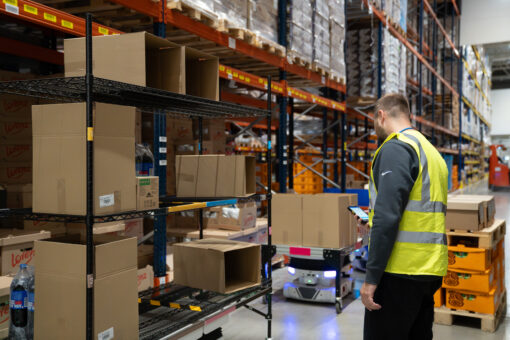WP: How to achieve 400 UPH with Locus Fast Pick
WP: How to achieve 400 UPH with Locus Fast Pick Download Now!
From Manual to Automated: 9 Steps to Updating Your Warehouse in 2024
Mary Hart, Sr. Content Marketing Manager

Warehouse managers face immense pressure to fulfill rising order volumes quickly and accurately. Adopting warehouse automation is the best thing you can do to handle these challenges, and the pathway to get there is lit well thanks to those who have automated before. Follow these 9 stops on the road to warehouse automation success to take your warehouse’s processes from manual to automated for optimized order fulfillment, happier associates, and more.
1. Know Your Current Operations Inside and Out
Before deploying warehouse automation, It’s critical to objectively assess every aspect of your existing workflows to see what’s working and what’s not. Document every step, measure cycle times, and identify any and all bottlenecks. Known warehouse pain points like repetitive tasks, order picking, and inventory management are prime automation targets. Since you can’t improve what you don’t understand, take a look at your whole warehouse operations first. You should also track productivity metrics now (if you aren’t already) so you’ll have them for comparison post-automation.
2. Define Your Automation Objectives
Automating your warehouse without a strategy in place is just asking for trouble. Clearly define the goals you want to achieve via automation and be specific — having a goal to “improve warehouse efficiency”, while important, is too vague.
Instead, set measurable targets like:
-
Increase picking speed by …%
-
Cut training time by …%
-
Reduce shipping errors by …%
Let your objectives guide your technology selection process and implementation roadmap.
3. Choose Solutions That Align with Your Goals
With the market full of conveyors, pickers, sorters and autonomous mobile robots (AMRs) — it’s no wonder that analysis paralysis is so common with all these options — it’s essential to select warehouse automation technologies that directly address your needs. If speed is critical, flexible AMRs can get your warehouse moving quicker than ever. Battling high turnover? Easy-to-learn robotics could help slash training requirements and encourage retention of your existing labor force. Define your must-have capabilities upfront to narrow options.
4. Plan for All Implementation and Operating Costs
Any warehouse manager who has deployed automation knows that it can require serious capital expenditure — unless you choose a solution that is offered “as a service” like a Robotics-as-a-Service (RaaS) solution. With RaaS, your facility’s automation costs shift from capital expenses (CapEx), which refers to major purchases that you plan to use for years, to day-to-day operational expenses (OpEx). The minimal initial investment means a simpler budget approval process and dramatically shortens your time to ROI from years to months.
Determine all potential warehouse automation costs upfront, including:
-
Initial hardware/software purchase
-
Facility renovation needs, if any
-
Integration with existing infrastructure
-
Employee training programs
Crunch the numbers to prove automation’s long-term ROI, accounting for future growth and get buy-in from finance stakeholders early.
5. Involve Your Full Warehouse Team from the Start
Nothing stalls a technology implementation like reluctant users, from your warehouse managers to associates and more. The way to get your project on the right track is to include and communicate with all of your employees from the start. Invite input on warehouse automation from associates to address any concerns that may be floating around.
Provide your associates with specific examples why automation is essential for efficiency and job growth, including that it will help to upskill them instead of replacing them. At the same time, show how warehouse automation will make their roles less physically taxing.
6. See Warehouse Automation Solutions in Action
As you’re traveling along the road to warehouse automation, consider a stop along the way to get help from a tour guide. In this case, that entails visiting a site where the warehouse automation solution has been deployed and talking to the people there about how it’s worked for them. This will give you a first-hand look at the solution and also ideas on how to implement it in your own warehouse.
7. Train, Train and Retrain Your Staff
No automation can succeed without warehouse associate buy-in. Think about it – people will only use a new technology correctly and happily if they understand it, so make 100% sure that your associates understand the solution. Invest heavily in training for all associates that will be using the automation solution. You may find that the warehouse automation technology you choose involves minimal training time because it’s so easy to use. If that’s the case, then your associates will be able to get hands-on experience and be up and productive quickly.
8. Ramp Up Gradually as Metrics Improve
Begin by using automation for targeted applications like relief for labor-intensive routes or seasonal spikes, such as peak season. As your team gets comfortable, slowly expand the technology’s applications across more warehouse functions. Use measured before-and-after analytics to confirm you’re progressing responsibly towards critical KPI boosts.
9. Continuously Optimize Based on Real Data
Just like manual processes, your warehouse automation has to continuously evolve to drive further benefits over time. Leverage dashboards and analytics tools to monitor how the solution is working in your warehouse, and analyze usage patterns for opportunities to tweak your processes or functionality.
Head Out on the Road to Warehouse Automation
Transitioning from a manual to an automated warehouse is a significant step towards improving your warehouse operations. While it requires careful planning, investment, and training, the long-term benefits — increased efficiency, accuracy, and productivity — are undeniable. With solutions like AMRs from Locus Robotics, this transition becomes more achievable, empowering you to meet any challenge in your warehouse with confidence and efficiency.
Want a guide for your warehouse automation journey? Discover the right robotic automation system to improve your warehouse operations by downloading the 2024 Warehouse Automation Buyer’s Guide for Robotic Solutions now!




